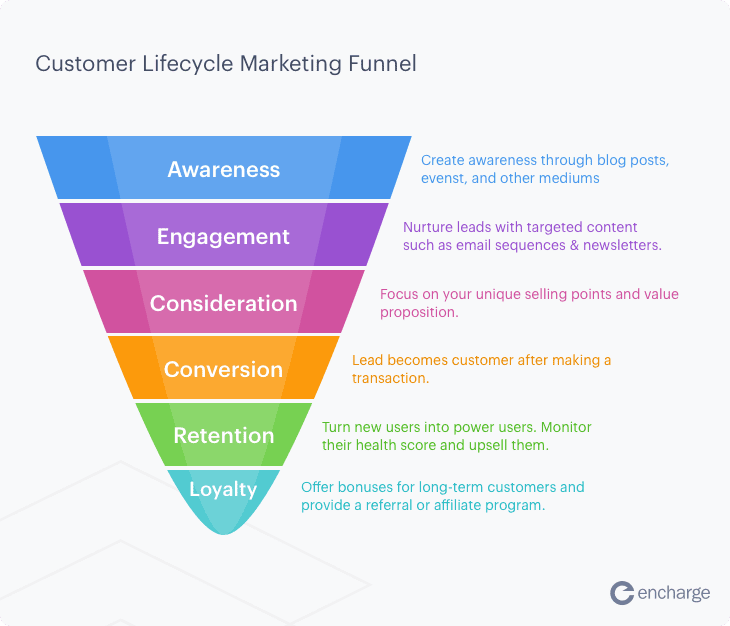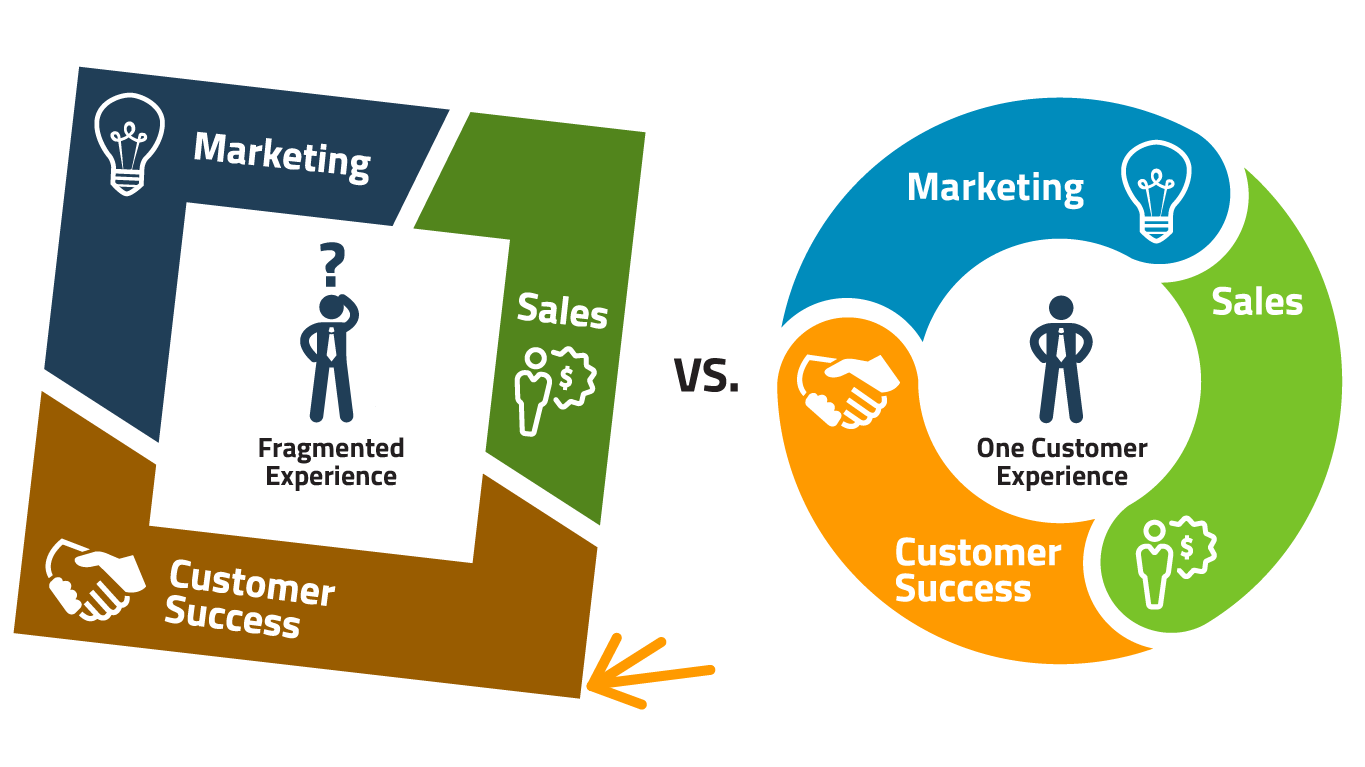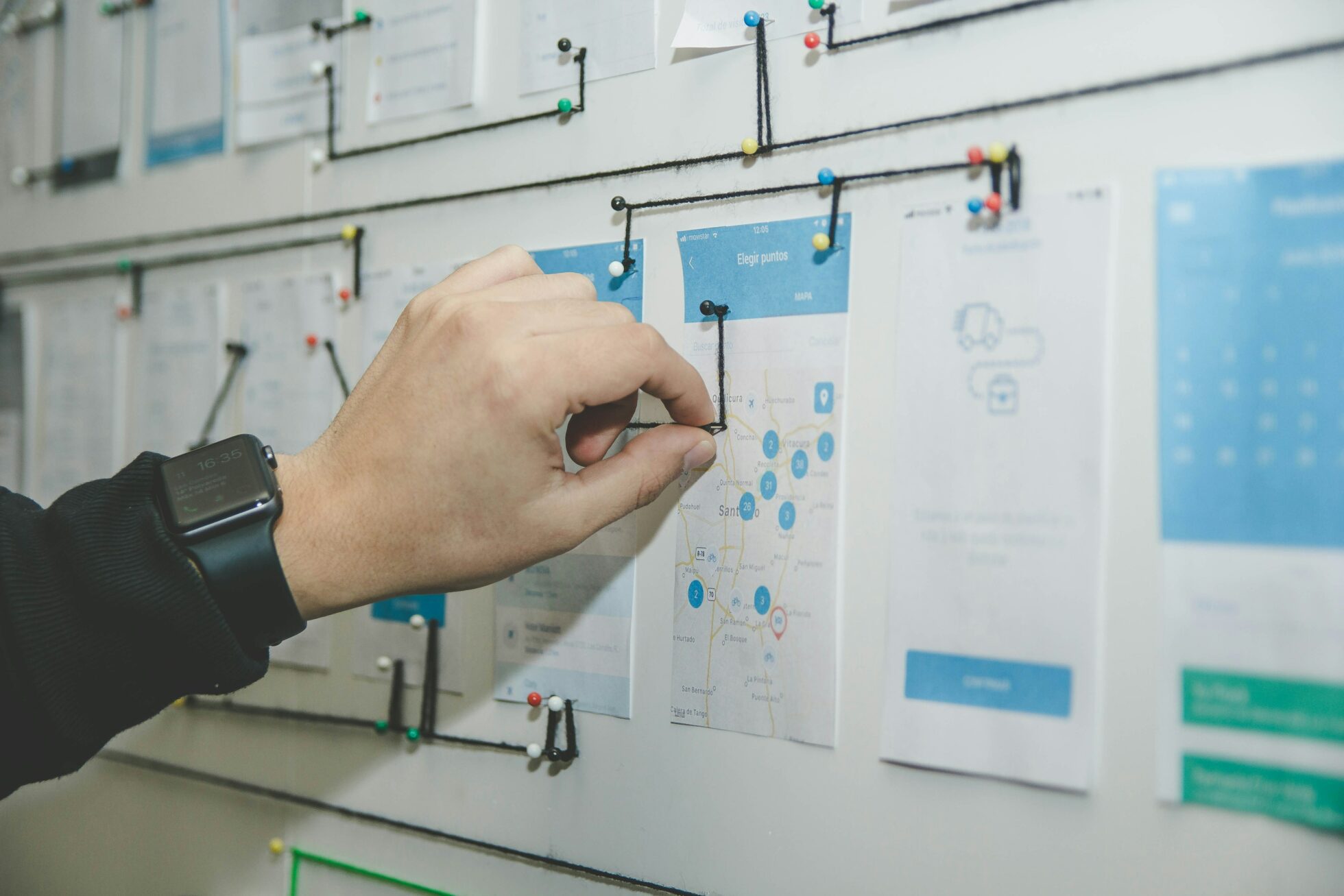Table of Contents
What Is the Customer LifeCycle?
First up, we’ve got marketing. This is where it all starts. Think of it as the ‘hello’ phase, where your brand introduces itself to potential customers. It’s all about making a good first impression, getting the word out, and sparking interest.
Once they’re interested, it’s over to the sales team. This is where the magic of persuasion and understanding customer needs comes into play. Sales take that initial interest, answer questions, iron out doubts, and hopefully, seal the deal with a purchase.
Now, once the purchase is made, that’s where Customer Success jumps in. Their job is to take the customer from just buying your product to absolutely loving it. It’s not just about fixing problems; it’s about making sure customers get the most out of what they’ve bought, which keeps them coming back for more.
While each area has its own part to play, Customer Success is often where the real power is. Not only do they keep customers happy, but they retain and prevent churn (and current customers spending more has a much better ROI than new sales), and when they create happy customers, these spread the word about your brand.
But to get to happy customers, each of these departments – marketing, sales, and customer success – is crucial. They all work together to move customers through different stages like Awareness, Consideration, Purchase, and beyond. Getting this journey right is what turns a one-time buyer into a long-term fan.
Stages of the Customer Lifecycle

Awareness
In this stage, it’s all about making that crucial first impression. You want to grab attention, spark curiosity, and start building a relationship with your audience.
This stage is crucial because it sets the tone for everything that follows. It’s not just about getting your name out there; it’s about strategically positioning your brand in the minds of your potential customers. You’re aiming to create a memorable brand identity that resonates with your audience’s needs and desires.
How do you do that? Through targeted marketing efforts like social media campaigns, content marketing, advertisements, and any other method that helps you tell your brand’s story in a compelling way. During this stage, creating attractive post graphics for your Facebook and other social media platforms can help establish strong brand recall and draw in more customers. This is where you highlight what makes your company unique, whether it’s your groundbreaking products, exceptional services, or the values that drive your business.To maximize your impact and streamline your audience’s journey, consider utilizing the best link in bio platform available. By strategically curating your bio link, you can seamlessly direct your audience to key content, promotions, or products, enhancing engagement and driving conversions effectively.
But it’s not just about broadcasting a message; it’s about starting a conversation. The Awareness stage is where you begin to engage with your audience, answer their initial questions, and address their needs. It’s an opportunity to position your brand as a solution to a problem they are facing or as a provider of benefits they are seeking.
Remember, the goal here is not an immediate sale; it’s about planting a seed in the minds of potential customers, a seed that will grow as they move through the subsequent stages of the customer lifecycle.
Consideration
This is where things start to get a bit more serious. The potential customer is thinking about it, you’ve grabbed their attention and now they are assessing whether or not to move through your funnel. This is where marketing and sales work together (and occasionally butt heads!)
Your (potential) customer is weighing their options, digging deeper into what you offer, and how it stacks up against the competition – interested, but they’re not committed yet. This is typically where they ask questions, or sales need to get them to reveal what their concerns are usually through carefully building rapport and poking those pain points.
The main job here is to provide as much helpful information as possible. This could be through detailed product descriptions, comparisons with competitors, customer testimonials, expert reviews, or even free trials and demos. The idea is to help potential customers understand why your product or service is the best fit for their needs. Ultimately not “it’s a great product” but more “this is a great product for THEM”.
It’s also crucial to engage with them at this stage. Whether it’s through responsive customer service, interactive content, or educational materials, you want to be there to guide them through their decision-making process. Addressing their doubts and concerns promptly and effectively can make all the difference.
Another key aspect of the Consideration stage is nurturing the interest that’s been sparked. This might involve follow-up emails, retargeting ads, or personalized content. The goal is to keep your brand at the forefront of their minds, gently guiding them towards making a decision.
Purchase
It’s time for the rubber to meet the road – the Purchase stage. This is where your potential customers make that all-important decision to open their wallets and go from ‘maybe’ to ‘yes, please!’
But hold on, it’s not time to pop the champagne just yet. While the sales team might be doing a victory lap, remember, this stage is crucial. It’s the moment that can make or break the customer experience.
Sometimes purchases can be complex and involve multiple stakeholders. This stage is where all the discussions, presentations, and negotiations culminate. It’s where trust and understanding between your business and your client get sealed into a formal agreement.
But even at this stage, things aren’t just cut and dried. It’s crucial to ensure that the entire purchasing process is as clear and straightforward as possible. This means providing detailed proposals, being transparent about pricing, and setting realistic expectations about what your service can deliver.
Communication is key. You’re not just selling a service; you’re offering a solution to a business problem. This means being on hand to answer any last-minute queries, providing reassurance, and making sure that all the i’s are dotted and the t’s are crossed in the contract.
This is also often where relationships are solidified. As great as the sales process is, this is where red flags can start to arrive and the clock starts ticking on whether or not they will churn. Ensuring a smooth purchasing process reflects the professionalism and efficiency of your service, setting the tone for the ongoing relationship. After the contracts are signed, it’s over to the Customer Success Team, who step in to ensure that your new client gets the most out of their investment.
Retention
Now, welcome to the Retention stage – also known as the ‘Please Don’t Ghost Us’ phase of the customer lifecycle. Post-purchase, this is where the real relationship-building happens. It’s all about making sure your customer doesn’t just use your product or service but actually loves it.
The honeymoon phase is over, and the real work begins. Remember it’s not just about providing a product or service; it’s about continually showing your customers why they chose you in the first place.
So, how do you make sure your customers don’t swipe left on you after the deal is sealed? First, by providing top-notch customer service that’s how! You want your customers to feel heard, understood, and taken care of.
Next up is gathering feedback, and yes, that means the good, the bad, and the ugly. You need to know what’s working and what’s not to keep improving and evolving. This feedback loop is essential to ensure you’re always aligned with your customers’ needs and expectations.
Then there’s offering support and resources. Whether it’s through helpful guides, training sessions, or regular check-ins, you’re there to make sure your customers are getting the most out of your product or service.
Don’t squander or get complacent at this stage. It’s a continuous effort of showing your customers that they made the right choice and giving them reasons to stick around for the long haul. Do this right, and you won’t just have customers; you’ll have brand ambassadors.
Advocacy
The final stage, and only if you’ve done it correctly, is the Advocacy stage – a sign that you’ve really nailed it with your customer experience. Here, your satisfied customers do something pretty amazing: they start spreading the word about your brand. Think of it as the ultimate pat on the back for your team’s hard work (plus a little extra boost for marketing and sales as well).
In this stage, your customers go beyond just being buyers; they become your brand’s informal ambassadors. They talk up your services to colleagues, share their positive experiences online, and in doing so, they bring something incredibly valuable to the table: genuine, heartfelt endorsements.
It’s not about flashy advertising here; it’s the power of genuine recommendations. When a customer vouches for your brand, it carries a level of trust and credibility that money can’t buy. They’re helping you reach new audiences in the most authentic way possible.
But it’s not just about getting good reviews. Advocacy indicates that you’ve built a real connection with your customers. They believe in your product or service enough to put their own reputation on the line for it. That’s a big deal.
To keep this momentum going, it’s important to stay engaged with your customers. Show appreciation for their support, maybe through a thank you note, a shout-out on your social media, or access to exclusive updates or events. Small gestures can make a big difference in strengthening this relationship.
The Interconnected Roles of Marketing, Sales, and Customer Success

The roles of Marketing, Sales, and Customer Success are not just linked; they’re fundamentally intertwined. Marketing kicks things off by generating awareness and leads, Sales steps up to convert these leads into customers, and Customer Success takes the baton to ensure these customers are happy, engaged, and getting the most out of their purchase.
The smooth handover and collaboration between these teams are essential, but it’s not always straightforward. This is where the art of communication and the right tools come into play. It’s critical for these departments to not just pass the baton, but to share the race strategy – that is, insights and data about the customer.
Let’s say someone from Sales wants to know if a client mentioned specific needs during their initial demo. Instead of trawling through emails or relying on memory, they can use tl;dv to quickly search through call recordings. They type in a query like “Does this client need any help with training?” and voilà – they get pinpointed answers from actual meetings, backed by real data.
This capability ensures that all teams have access to a rich, searchable repository of customer interactions. This means Marketing can refine their campaigns based on real feedback, Sales can tailor their follow-ups more effectively, and Customer Success can proactively address customer needs – all leading to a more personalized and successful customer journey.
In essence, the synergy between Marketing, Sales, and Customer Success is what makes or breaks the customer experience. Tools like tl;dv are not just helpful; they’re essential in making this collaboration as effective as possible, ensuring that every customer feels understood and valued throughout their journey.
How can call recordings help the Customer Lifecycle
Let’s dive into actionable tips for each stage of the customer lifecycle, leveraging the capabilities of tl;dv to enhance each department’s effectiveness:
1. Awareness Stage (Marketing): Utilize tl;dv to analyze customer feedback from webinars and social media Q&As. Identify common questions and topics to inform your content strategy, ensuring your messages resonate more effectively with your target audience.
2. Consideration Stage (Sales): Sales teams can use tl;dv to review past successful sales calls and identify key factors that led to conversions. This insight helps in tailoring pitches and presentations to address potential customers’ specific concerns and needs more precisely.
3. Purchase Stage (Customer Success): Post-purchase, use tl;dv to review onboarding calls and identify common areas where new customers need more clarity or assistance. This enables the creation of targeted resources or FAQs to streamline the onboarding process for future clients.
4. Retention Stage (Customer Success): Regularly review check-in calls and support interactions using tl;dv to spot trends or recurring issues. This information can guide proactive measures for customer support, ensuring ongoing satisfaction and reducing churn.
5. Advocacy Stage (Marketing and Customer Success): Leverage tl;dv to gather positive feedback and testimonials from follow-up calls or feedback sessions. Use these insights to create compelling case studies or to identify potential brand ambassadors for your advocacy campaigns.
By integrating tl;dv into these stages, each department can harness specific insights to optimize their strategies, leading to a more cohesive and effective customer lifecycle management.
Goodbye Customer Drama, Hello Success Saga
Mastering the customer lifecycle is crucial for your team’s triumph. Every stage, from first awareness to steadfast advocacy, brings its own set of opportunities and hurdles. Navigating these effectively is key to elevating the customer experience. When you ace each phase, you’re not just boosting customer happiness and loyalty; you’re fueling your business’s growth and success.
tl;dv can be massive game-changers in this journey, no matter who your customers are or what your products are. For any customer lifecycle it can help to provide the insights and agility needed to respond to customer needs at every turn. Try tl;dv today totally free and watch it transform your customers into “OMG YOU ARE THE BEST THINGS EVER” people.
Ensure your team follows your winning Playbooks
Define your winning Playbook per Deal Stage, and let our AI handle the analysis. Monitor how well your sales team follows it and where new hires have opportunities to improve their win rates. Provide private feedback directly on each meeting.
Tackle Customer Objections with AI
Understand how your team handles common customer objections across hundreds of calls.
Spot where they excel and where they can improve to win more deals!
Onboard new reps 2X faster
Organize clips and reels of what great sales calls look like according to your own playbooks.
Watch your Reps save 30 minutes on each meeting
Improve overall team efficiency and ensure each rep can save over 4 hours each week by automating meeting preparation, follow-up emails and CRM updates.





